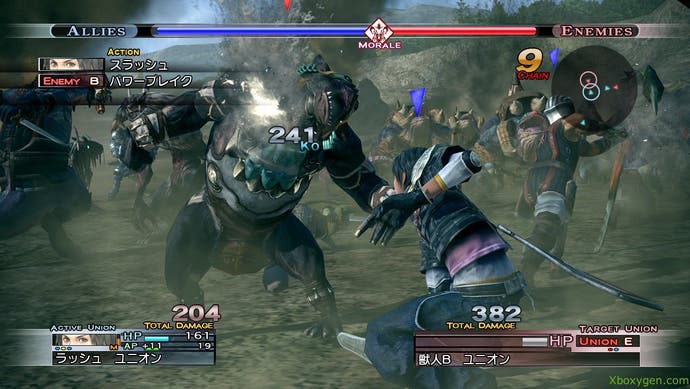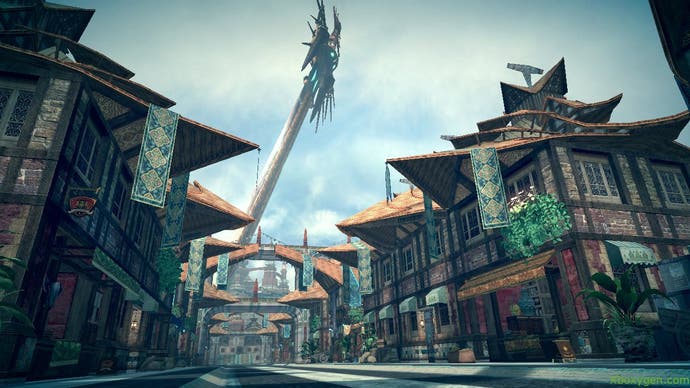Square-Enix Party 2007
Last Remnant and Chocobo's Dungeon unveiled.
Last Remnant
The second big announcement of the day was Last Remnant, details of which had leaked onto the Internet a few days before the press conference. Allegedly a response to the (entirely legitimate) criticism that the company has been drawing too heavily on the Final Fantasy legacy, Last Remnant is to be a new IP, designed to sit alongside their flagship games as a new 'global hit series' .
Set to be simultaneously released in Japan and the US on both 360 and PS3 (two firsts for the company) Last Remnant uses the Unreal Engine - something which has clearly helped speed the game's development along since full-scale production began less than a year ago. Square Management's excitement over the game was palpable as Akitoshi Kawazu (Executive Producer on Final Fantasy XII) explained how the company has brought together a new team of young designers with the instruction to revolutionise RPGs.
However, any initial rush of excitement at the possibility of seeing Square innovating in the genre they helped define quickly dissipated upon watching the first two of three Last Remnant videos. While the opening sequence of the game was technically solid, showing a young androgynous boy rushing through a forest looking for a friend before witnessing a huge-scale battle scene, it was also based firmly in Lord of the Rings cliché, armour-bearing, boulder-throwing monsters et al.

The second video offered a view of the map screen and various locations in the field - all of which looked remarkably close to those enjoyed in Final Fantasy XII. One city, Athlum, was decidedly Rabanastre-esque featuring a similar colour palette as well as presenting various inhabiting races wandering around. The key difference between the two cities was in Athlum's gigantic sword - a towering construction and one of the titular remnants, which loomed over the residents 200 metres into the air.
To travel between locations the game employs a Fire Emblem-style cursor that the player uses to select firstly which location on the world map to travel and then which part of town. This, perhaps worryingly, implies that you won't be able to walk from location to location through the environments - something many gamers have come to expect from their modern RPGs.
Obviously it's early days but graphically the lighting was rudimentary and the textures on the ground of a low quality. Conversely the motion capture on the lead character in the opening movie (all rendered in the game's engine) was impressive as was the sheer level of detail in the character models. Indeed, some of the close ups on hands showboated incredibly high levels of detail. Nevertheless, there was little we haven't seen before albeit with a little more polish here.

Until, that is, the Battle System Director Hiroshi Takai, took centre stage and talked through an astonishing gameplay movie of the game's central conceit: large scale battles. The fight we were shown took place on the huge plain first seen in the game's opening movie. Takai insisted that there are to be no random battles as each fight will be on an 'unprecedented scale' in which new enemies can join in fights to bolster their allies numbers enlarging the battle's geography.
During combat the camera swings and lunges with cinematic flair circling all the involved characters as the player inputs various moves. Attacks seem to be a complex mixture of macro directions (for example one group of mages targeted a group of enemies marching on top of a cliff in the distance wiping them out in one spell) as well as micro management and even Quick Time Event-style against-the-clock button presses.
Takai explained how morale in your squads can ebb and flow as the battle develops and how, as enemies group together to fight you with reinforcements, what looked like a straightforward fight can turn nasty. At one point the enemy squad summoned a huge dragon -a dramatic move which the main character countered by calling upon a gigantic clockwork Cyclops to fight alongside his team.
What's difficult to express in words is quite how effective the camera is in drawing the player into the action. The sequence was clearly a recording of somebody playing the game and yet the game still managed to communicate much of the cinematic drama seen in the close up battlefield scenes in movies such as Gladiator and 300. With dynamic audio shifting to match the action on screen this appears to be an extremely significant and dramatic development in RPG battle systems.
Last Remnant lends dramatic substance to Wada's assertion that the company is seeking to forge new paths in videogames. However, neither game particularly seems to fit the bill of appealing to a wider, more mainstream audience at this early stage and it will be interesting to see how the company manages to realise expansion of vision without alienating their already significant dedicated fan base.
Check back with Eurogamer over the next few days for first impressions of some of Square-Enix's games nearing completion.
